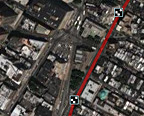April 04, 2006
eRuv: A Street History in Semacode

Inscribing a Story on a City with 2D Barcodes
eRuv is a digital graffiti project installed along the route of the former Third Avenue elevated train line in lower Manhattan. The train line, dismantled in 1955, was more than just a means of transport; it was part of an important religious boundary — an eruv — for a Hasidic community on the old Lower East Side. Using semacodes, the former boundary is reconstructed and mapped back onto the space of the city. Pedestrians with camera phones can then access location-specific historical content linked through the semacodes.
What is an eruv? An eruv (pronounced ey-roov) is a structure erected around orthodox Jewish communites throughout the world. It usually consists of a series of poles connected by a cord that circumscribe an urban neighborhood, often incorporating existing municipal infrastructure such as utility poles and electrical wires. They are erected with the permission of local authorities and in accordance with the lengthy and complex set of architectural laws set forth in the Talmud. The construction of eruvin (or eruvim, plural for eruv) stems from the observation of Shabbat, the weekly sacred day of rest (Friday sundown to Saturday sundown) that includes a prohibition against carrying objects outside of one's home, or private domain. The reason Jews construct eruvin is that according to most Rabbinic authorities, the shared public space within an eruv is considered the private domain of a community. In this way, observant Jews can carry their keys or prayer books on the Sabbath while acting in accordance with sacred principles.
Is Manhattan an eruv? Natural topographic boundaries such as rivers, cliffs and ravines can also form one or more legitimate sides of an eruv. For this reason, it is possible from a number of Talmudic perspectives to consider the entire island of Manhattan an eruv. This has been debated over the centuries-long course of Jewish habitation in the city — rabbis differ over the extent to which the island would require physical intervention for it to qualify as an eruv.
The old East Side eruv: In 1907, Rabbi Yehoshua Siegel, a renowned Talmudic authority who had immigrated to the Lower East Side from Poland, published Eruv V'Hotza'ah, in which he wrote:
With regard to the city of New York, where we are presently living, the issue has come before the trembling ones that it is possible to permit carrying on Shabbat throughout the East Side. The argument is that the water which surrounds it on three sides should be considered a complete wall because of its depth. The fourth wall is a door frame like none other: the elevated iron pathway which stretches the length of the city, from one end to the other, from the water of the southern tip, South Ferry, to the water at the northern tip, without any interruption to Harlem.
The eruv was soon refuted by other prominent rabbis and rejected en masse by Lithuanian Jews who also lived on the Lower East Side at the time.
What is semacode? A semacode is like a bar code that you see on your groceries. Except that instead of holding product information it represents a URL, or web address. You can print semacodes on a piece of paper or on an adhesive sticker and put them places. This way you can put web addresses on walls or streets, or on anything. In order to use them, you need a semacode reader, or a compatible camera phone that is connected to the Internet.
Visit eRuv for more information
Posted by jesse at April 4, 2006 07:18 PM
